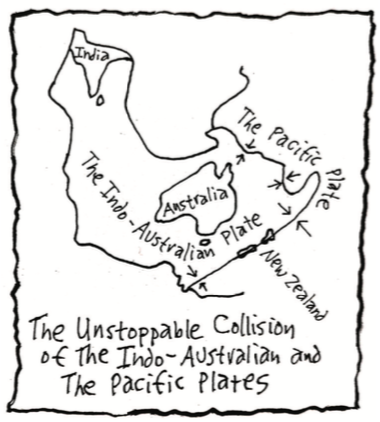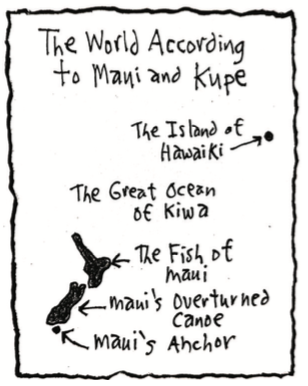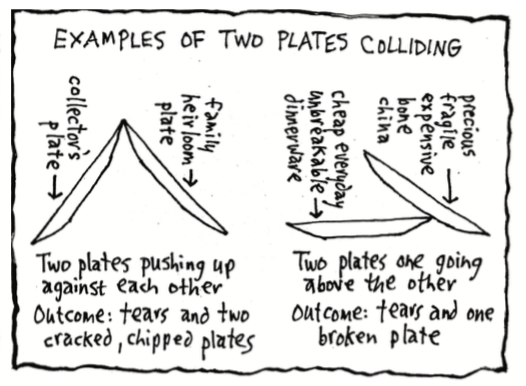Theory Two is much shorter than Theory One. It says that the Archaic Maori arrived in the year 1,200 A.D., and then just evolved over the next 300 years to become the Classical Maori by the year 1,500 A.D. (sort of like a teenager liking pop music and then evolving into an adult and liking classical music instead).

Theory Three of how people first came to New Zealand, is the Maori legend version (there had to be one). When we left the story of Maui and his brothers, the North Island of New Zealand (formerly a giant fish), and the South Island of New Zealand (formerly a giant upturned canoe), had been left forgotten about in the Great Ocean of Kiwa; because Maui had been killed by the Goddess of Death, and his brothers abandoned on the giant fish with nothing to eat because the fish had been turned into solid rock by the Sun.

It was not until the year 925 A.D. that New Zealand was rediscovered by Kupe who was from the island of “Hawaiki” (thought to be either the Society Islands or the Cook Islands). Kupe was not a particularly nice fellow however. He murdered a wood carver and took his canoe and his wife and sailed off south and west from Hawaiki, pursued by the relatives of the wood carver and his wife. In the course of trying to escape from them Kupe found “The Fish of Maui” which he renamed “Tiritiri o te Moana” (the Gift of the Sea).
Kupe and the wife of the wood carver lived there for awhile, but it was a lonely place as there was nobody else to talk to (there is no mention of them finding any trace of Maui’s brothers). So they packed up and returned to Hawaiki where they told everybody else there what they’d found, causing a great migration of canoes to New Zealand 400 years later (the people of Hawaiki were not in any great hurry to rush off and live on a deserted formerly giant dead fish).
Two people who did follow Kupe’s directions to New Zealand sooner than the rest, were Toi and his grandson Whatonga. Whatonga was competing in a canoe race in 1,150 A.D. when a storm came up and blew him far out to sea. Toi set out to look for him, but Whatonga returned to Hawaiki after Toi had already left. When Whatonga found out that Toi had gone looking for him, he set out to go looking for Toi (like grandfather, like grandson). They eventually ended up both finding each other in Whakatane, Bay of Plenty, North Island, New Zealand, where they also found other people living there too, some of whom liked and some of whom didn’t like classical music. Toi stayed in Whakatane, but Whatonga moved south around the coast to the Mahia Peninsula, Hawke’s Bay, as the grandfather and grandson found out that once they’d found each other, they really had very little else in common except canoe racing and looking for each other in the open ocean.
Two hundred years after Whatonga and Toi has settled in New Zealand, there were so many people living on Hawaiki that they were afraid it was going to sink. And then someone remembered the story that Kupe and the wife of the wood carver had told them, and there was a great migration from Hawaiki to New Zealand in at least 12 great canoes, each with its own name (1,350 A.D.).
It is from these people that the present-day Maori of New Zealand are descended. (When a Maori dies in New Zealand their spirit goes north to Cape Reinga at the very northern tip of the North Island, where it drinks from the water-of-the-underworld stream, climbs down the roots of a tree, and swims underwater through the Great Ocean of Kiwa to the spirit world located somewhere near Hawaiki.)
Irregardless of how they got there, by theories One, Two or Three or any other; it’s the descendants of the Classical Maori or the people of Hawaiki who the Dutchman Abel Tasman came across in 1642, and the British Navy Lieutenant James Cook in 1769.

If you enjoyed this BFD article please consider sharing it with your friends.
- Chapter One Part one: A Humorous History of NZ
- Chapter One Part two: A Humorous History of NZ
- Chapter Two Part one: NZ is Formed
- Chapter Two Part two: NZ is Formed
- Chapter Three Part One: People Come to NZ
